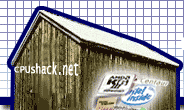


 |
 |
 |
| home | about | pictures | reference | trade | links |
NATIONAL SEMICONDUCTOR ANNOUNCES PROMISED EMBEDDED NS486, AT $15
(September 11th 1995) Rather than join the rush to clone Intel Corp's x86
chip architecture and go head-to-head with the company knowing that it
holds all the aces, National Semiconductor Corp has decided to carve out
its own little 86 niche, and it has developed an 80486 core for use as
the basis of a family of microcontrollers. Intel should not be too
surprised to find yet more clones of its architecture coming to market:
NatSemi warned last October after it took an 8% stake in Intel maths
co-processor cloner - and foundry customer of NatSemi - that it was
thinking of doing an 80486 clone family for embedded applications. The
NS486, which is rather more powerful than most microcontrollers but is
thought by NatSemi to have a bright future because so many developers
are skilled in writing for x86 architecture, is designed to go into
things such as copiers and facsimile machines.
The launch is something of an admission of defeat for NatSemi: it
originally hoped to sweep the world with its NS32000 family of general
purpose microprocessors, but garnered too few design wins and one by
one, the ones it did have dropped out. It sought to retrieve the
situation by coming out with a family of embedded variants, with the
laser printer controller market the primary target, and in the early
days of the laser mass-market made some good design wins. But most have
since defected with the Am29000 and the R-series RISCs picking up most
of the business these days.
NatSemi has high hopes for the part in television set-top boxes: the
price is right, and the power is likely to be needed there. Other target
applications include personal organisers and communicators, telephones
and point-of-sale and handheld terminals. The two initial products in
the NS486 series, the NS486SXF and NS486SXL, are based on an 80486 core
that NatSemi designed from the ground up for embedded applications; the
NS486SXF incorporates a three-stage pipeline and 1Kb on-board cache;
there is no table look-aside buffer or maths co-processor because those
are superfluous. It incorporates a set of input-output controllers
tailored for embedded applications and has an AT-compatible bus for
direct connection to AT peripherals.
The memory controller is optimised for fast page-mode dynamics and
supports one or two banks for up to a total of 16Mb; there is a Direct
Memory Access controller, real-time clock, timers and oscillator and
programmable interrupt controller. Peripherals on board the NS486SXF
include a liquid crystal display controller, PCMCIA slot controller,
UART/HP Serial IR, ECP parallel port and a "three-wire" serial interface
supporting Access.bus and Microwire plus protocol. The power management
scheme enables selective control of individual inout-ouput subsystems
with varying levels of power consumption, and individual peripherals can
be disabled. The NS486SXL omits the PCMCIA controller, ECP parallel port
and display controller. The optimised core boots up in protected mode
and operating systems and kernels supported include VxWorks, VRTX, pSOS+
and QNX Neutrino. No mention of clock speeds. The NS486SXF is sampling
now and is out in volume next quarter at $25 in OEM quantities. The
NS486SXL, $15, is one quarter behind big brother.